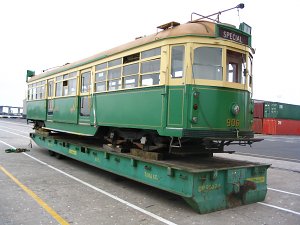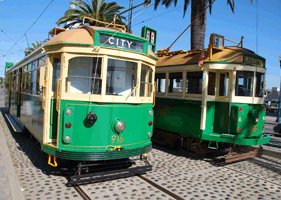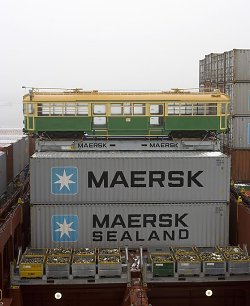Melbourne Tram Museum
- Follow Melbourne Tram Museum on Twitter
- Follow Melbourne Tram Museum on Facebook
- Follow Melbourne Tram Museum on Instagram
- Follow Melbourne Tram Museum on Pinterest
- Follow Melbourne Tram Museum on Tumblr
- Subscribe to Melbourne Tram Museum's RSS feed
- Email Melbourne Tram Museum
Melbourne trams to the world
As every resident of Melbourne knows, the W class tram is the iconic symbol of our city that is recognised around the world. The last of these tramcars, W7 class number 1040, was built in 1956 and is now resident in the Melbourne Tram Museum, while a small number of other W class cars remain in service on the City Circle and other heritage routes in Melbourne.
The longevity of the W class tramcars has been due to the robust engineering of the original design, which resulted in a reliable, high capacity and effective means of street public transport. This has been recognised by many international heritage tramcar operators and museums, so many W class tramcars have found new homes overseas after they retired from service in the streets of Melbourne. These homes have varied from Elton John’s garden in the UK to a number of heritage tramways in the United States, including Seattle, Memphis and Dallas.
In recent years, the State Government has given W class tramcars to a number of international organisations to promote Victoria as a tourist destination.
Royal Danish
The marriage of former Melbourne resident Mary Donaldson in 2004 to HRH Crown Prince Frederik of Denmark, the heir to the Danish throne, was marked by a most unusual gift from the people of Victoria – SW6 class tram number 965. This tram was built in October 1950, finishing up its service life allocated to Glenhuntly Depot. After withdrawal in the late 1990s, it went into storage as a reserve tram for the W class trams remaining in service on the Melbourne network.
On 10 November 2005, the Hon. Peter Batchelor, Minister of Transport, presented a restored number 965 to the Danish Consul-General, Jorgen Mollegaard at a ceremony at Preston Workshops. It was then transported on the container ship Gudrun Maersk to Denmark, where it was taken to its permanent home at the Danish Tramway Museum.
After a shakedown period, HRH Crown Prince Frederik and HRH Crown Princess Mary visited the museum on 23 May 2006 to accept the unusual gift from the Victorian people. In a ceremony conducted in slightly inclement weather reminiscent of Melbourne, the Danish royals inaugurated the tram into heritage service by driving it from the museum depot to the terminus, before returning in a historic Copenhagen tram.
Number 965 continues its new life on the other side of the world, bringing delight to visitors to the Danish Tramway Museum and strengthening ties between the nations of Australia and Denmark.
 SW6
number 965 on its first test run in the snow at the Danish Tramway
Museum, February 2006.
SW6
number 965 on its first test run in the snow at the Danish Tramway
Museum, February 2006. - Photograph courtesy Morton E. Storgaard.
Aoteroa
A number of W class trams have ended up in the land of the long white cloud (New Zealand). The State Government has presented three trams to the Museum of Transport and Technology (MoTAT) in Auckland – W2 class number 321 in 1981, and SW6 cars 906 in 2006 and 893 in 2008.
Two other W2 class tramcars went to New Zealand in the 1990s, arriving through differing routes at the Christchurch Tramway. Number 244 originally went to the Newcastle Tramway Museum in NSW, but after it closed the car was purchased by the Tramway Historical Society (THS) to run on its tramway in Ferrymead Heritage Park. On the opening of the City tramway in Christchurch, the THS leased the car to the operator, where it remains today. Number 411 also went to New Zealand via NSW, where it was modified into a restaurant tram before entering service in Christchurch.
 SW6 class number
906 loaded on a flat rack container ready for shipping to MoTAT, Auckland,
New Zealand in 2006.
SW6 class number
906 loaded on a flat rack container ready for shipping to MoTAT, Auckland,
New Zealand in 2006. - Photograph courtesy Ian Menzies.
On the High-level Bridge
SW6 class car 930 was built in 1947 and withdrawn from active service in 1997. After some years of storage, in 2003 it was donated to the Edmonton Radial Railway Society in Canada, arriving in Edmonton in February 2004. It was immediately tried out and unfortunately promptly derailed, as the tramcar wheel profile did not match the railway style track.
After having the wheels reprofiled, number 930 entered service on the High Level Bridge line, which runs for three kilometres from Jasper Plaza to the Strathcona Car Barn. Spectacular views are enjoyed by passengers as the tram crosses the High Level Bridge across the North Saskatchewan River, one of the tallest and longest tramway bridges in the world.
It operates in conjunction with Osaka car number 247 and Hannover car 601, two other tramcars like number 930 that have found a secure future a long way from their original home.
 SW6
tram number 930 in snow after arrival at Edmonton, 18 February 2004.
SW6
tram number 930 in snow after arrival at Edmonton, 18 February 2004.
- Photograph courtesy VicTrack.
Open Your Golden Gate
The latest Melbourne tram to depart for foreign shores is another SW6 class tram, number 916. It has been given to the San Francisco Muni Railway in California USA for operation on its heritage F-line along Market Street, joining another two former Melbourne trams, W2 class numbers 496 and 586, which have been in the city since 1984.
Number 916 departed Melbourne on 10 August 2009 on the APL Bangkok, and arrived in San Francisco on 11 September 2009. It was formally handed over to the Muni by Premier John Brumby on his visit to San Francisco on 7 October 2009. San Francisco Mayor Gavin Newsom accepted the gift on behalf of the Muni.
Also present at the handover ceremony was W2 tram 496. It will be some time before 916 enters traffic, as some modifications need to be made for Muni service, including changing the door controls so that the driver’s door valve opens the doors on the right side of the car, rather than the left.
“I am delighted that this tram has found a new and very welcome home here and will be used for F-line services. It is with great pleasure that the Victorian community can once again donate one of our iconic W-class trams to the people of San Francisco,” said Brumby speaking at the opening ceremony.
“We are grateful to the people of Melbourne for this generous gift. Both of our cities understand the importance of preserving our history and using that preservation to promote environmentally-sustainable transportation. I am certain that our shared values will keep Melbourne and San Francisco beautiful and livable for generations to come,” said Newsom.
 Former
Melbourne trams SW6 916 and W2 496 together in San Francisco on The
Embarcadero on the day of the launch.
Former
Melbourne trams SW6 916 and W2 496 together in San Francisco on The
Embarcadero on the day of the launch. - Photograph courtesy Market Street Railway.
Shipping a Tram Overseas
The process of shipping a Melbourne tramcar overseas is not a simple one. Melbourne Tram Museum Board member Rod Atkins has been intimately involved with transporting a number of the trams mentioned above, due to his employment in the shipping industry. The size and shape of a Melbourne W class tramcar does not lend itself to easy transport, so special arrangements have to be made to ensure safe arrival at its new home.
An export permit may be required under the Protection of Movable Cultural Heritage Regulations administered by the Federal Department of the Arts. This will only apply if the tramcar is of a rare type or is in itself culturally significant. However, these regulations have not been applicable to the tramcars donated by the government so far, as none of the trams exported have been of rare types or are individually culturally significant.
The usual method of moving freight by sea is through the medium of standard forty foot containers. However, a Melbourne W class is too long, wide and high to fit in a container, which adds significantly to the complexity of shipping a tram by sea. Fortunately, the weight of a tram at about eighteen tonnes is not a problem.
The answer to this shipping problem is to use a special type of container called a forty foot flat rack with collapsible ends. This allows an over-dimensional load to be carried on a standard container base.
Obtaining a flat rack can be difficult as there may not be one in Melbourne, so it may be necessary for the shipping company to arrange one to be transported from another location, possibly from overseas. Meanwhile, a freight forwarder must be engaged to handle the complex paperwork and customs clearance.
Before the tram can be loaded on to the flat rack it must be thoroughly steam-cleaned inside and out to prevent any quarantine problems. Even the sandboxes have to be emptied to ensure that no biological nasties are transported overseas. After the tram has been cleaned by an accredited company a compliance certificate is issued.
When loading the tram on to the flat rack, the tram wheels are placed on a dunnage (timber) raft, to prevent any damage occurring to the flat rack and stopping the tram from accidentally shifting. The tram is lashed down to the flat rack using webbing straps through the drop centre, and chains through the bogies. It is then transported to the port by an accredited road transport company specialising in over-dimensional loads. This requires close liaison with the terminal operator as the tram will not go into the container park for later loading, but instead directly ‘under the hook’ for immediate loading on to the ship. This will prevent the tram from being damaged due to the over-dimensional nature of the load.
The tram is usually one of the last containers loaded on to the ship, as it must be placed on the top tier of a container stack. Usually this is on deck rather than under deck due to clearance problems that may occur under deck. However, use of a flat rack leads to its own set of problems as then the tram is exposed to salt spray and adverse weather conditions when in transit on board ship. Therefore, it is desirable to specify the container for protected stow, so that it is surrounded by other containers to provide some partial protection from the spray and weather.
 Royal
Danish tram Melbourne SW6 class number 965 looking more like a model
on top of a container stack on board the Gudrun Maersk on arrival
at Aarhus, Denmark, 19 February 2006.
Royal
Danish tram Melbourne SW6 class number 965 looking more like a model
on top of a container stack on board the Gudrun Maersk on arrival
at Aarhus, Denmark, 19 February 2006. - Photograph courtesy Mikael Lund..
Once the tram is loaded on board the container ship all that is required is for it to arrive safely in the destination port. All in all, the entire exercise from initial selection of a tram for donation to an international heritage tramway to the car arriving in its destination port can take up to twelve months in the planning and execution from go to whoa.
The end result is that an iconic Melbourne tram will appear in a city on another continent, for people to enjoy an authentic antipodean heritage transport experience.
Bibliography
Media release from Minister of Transport, 10 November 2005
VICSIG –
Victorian Rail Resource, 10 August 2009